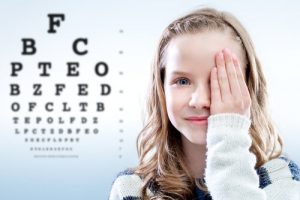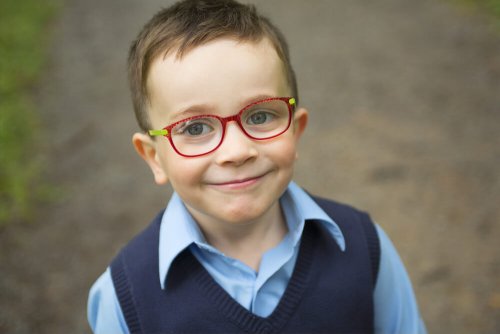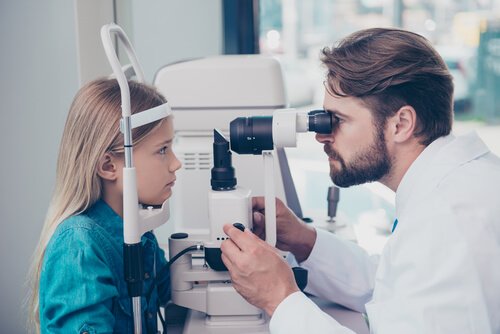All You Need to Know About Astigmatism in Children

Astigmatism in children is a visual disorder in which observed objects are deformed, either from near or far. Its correction depends on early detection and treatment. This disorder occurs when the cornea acquires an oval shape rather than its usual concave shape.
Astigmatism is one of the least understood vision disorders. However, one thing that is understood about astigmatism is that it occurs due to a reactive error similar to nearsightedness or farsightedness.
Therefore, we can state that astigmatism is not an eye disease, but rather an ocular anomaly that occurs while focusing on objects.
When a person has astigmatism, what occurs is that when light reaches the retina, an identical image is not produced. Rather, several images and different points of focus are created.
Causes of astigmatism in children
Several theories have been founded to try to explain the cause of astigmatism in children. The leading theory suggests that it is caused by genetics and therefore hereditary. It has been proven that certain surgical interventions such as corneal transplants and cataract surgery can also cause this condition.

What are the symptoms of astigmatism in children?
Astigmatism is closely related to myopia and hyperopia, therefore they share the same types of symptoms. Here is a list of the most common symptoms of astigmatism:
- Headaches.
- Congestion.
- Itchy eyes.
- Dizziness.
Children with astigmatism may also experience visual fatigue and headaches, especially after spending a long time reading or focusing on a certain object.
Types of astigmatism
There are three types of astigmatism and their characteristics are as follows:
- Myopic astigmatism. This occurs when the meridians of the eye focus close-by (nearsighted). This condition can occur with different degrees of severity.
- Hypermetropic astigmatism. This occurs when the meridians of the eye focus far (hyperopic or far-sighted). This can also occur with different degrees of severity.
- Mixed astigmatism. This occurs when one eye’s focus is myopic and the other is hyperopic.
Astigmatism can also be classified as regular or irregular.
Regular astigmatism
This occurs when the meridians are perfectly perpendicular to one another forming a 90 degree angle.
Irregular astigmatism
This occurs when the meridians aren’t perpendicular. When this occurs the frontal surface of the cornea takes on an oval shape similar to an American football.
How is astigmatism detected?
Astigmatism can be detected through visual tests. The same devises used to detect myopia and hyperopia can be used to diagnose this condition. A fairly common test known as a retinoscopy can be used as well. This test evolves the use of several lenses and a light source.
There are also more advanced methods to diagnose astigmatism using automated devices. These devices can diagnose a wide array of ocular disorders with precision and accuracy.

Treatment for astigmatism in children
- Visual disorders such as hyperopia, myopia and astigmastism can all have negative consequences on a child’s health if they aren’t corrected in time. These disorders can have negative repercussions on a child’s education and social life.
- The most common and effective treatment for astigmatism in children is the use of appropriate glasses. In some cases the use of glasses is all it takes to correct the disorder. When it comes to younger children, they should be provided with glasses with rubber frames and unbreakable lenses.
How common is astigmatism?
This corneal disorder usually appears from an early age. That’s why it’s very important to take your child to the pediatrician periodically for eye exams.
A study was conducted in the United States involving 2,523 children between the ages of 5 and 18. The study concluded that Asian and Hispanic children have the highest prevalence rates (33.6% and 36.9% respectively). They also concluded that 26.4% of Caucasian children and 20% of African American children suffer from astigmatism.
Another study was conducted in the UK involving 11,000 children and adults with glasses. They concluded that 47% had astigmatism of 0.75 or greater. They also noted that the prevalence of myopic astigmatism was 31.7%, almost twice as much as hypermetropic astigmatism which had a prevalence of 15.7%
“Astigmatism can be corrected with the use of glasses.”
To be cautious, it’s best to take your children to the ophthalmologist (eye specialist) to have a check-up at least once a year. Taking care of their eye-sight is fundamental to their overall health.
Astigmatism in children is a visual disorder in which observed objects are deformed, either from near or far. Its correction depends on early detection and treatment. This disorder occurs when the cornea acquires an oval shape rather than its usual concave shape.
Astigmatism is one of the least understood vision disorders. However, one thing that is understood about astigmatism is that it occurs due to a reactive error similar to nearsightedness or farsightedness.
Therefore, we can state that astigmatism is not an eye disease, but rather an ocular anomaly that occurs while focusing on objects.
When a person has astigmatism, what occurs is that when light reaches the retina, an identical image is not produced. Rather, several images and different points of focus are created.
Causes of astigmatism in children
Several theories have been founded to try to explain the cause of astigmatism in children. The leading theory suggests that it is caused by genetics and therefore hereditary. It has been proven that certain surgical interventions such as corneal transplants and cataract surgery can also cause this condition.

What are the symptoms of astigmatism in children?
Astigmatism is closely related to myopia and hyperopia, therefore they share the same types of symptoms. Here is a list of the most common symptoms of astigmatism:
- Headaches.
- Congestion.
- Itchy eyes.
- Dizziness.
Children with astigmatism may also experience visual fatigue and headaches, especially after spending a long time reading or focusing on a certain object.
Types of astigmatism
There are three types of astigmatism and their characteristics are as follows:
- Myopic astigmatism. This occurs when the meridians of the eye focus close-by (nearsighted). This condition can occur with different degrees of severity.
- Hypermetropic astigmatism. This occurs when the meridians of the eye focus far (hyperopic or far-sighted). This can also occur with different degrees of severity.
- Mixed astigmatism. This occurs when one eye’s focus is myopic and the other is hyperopic.
Astigmatism can also be classified as regular or irregular.
Regular astigmatism
This occurs when the meridians are perfectly perpendicular to one another forming a 90 degree angle.
Irregular astigmatism
This occurs when the meridians aren’t perpendicular. When this occurs the frontal surface of the cornea takes on an oval shape similar to an American football.
How is astigmatism detected?
Astigmatism can be detected through visual tests. The same devises used to detect myopia and hyperopia can be used to diagnose this condition. A fairly common test known as a retinoscopy can be used as well. This test evolves the use of several lenses and a light source.
There are also more advanced methods to diagnose astigmatism using automated devices. These devices can diagnose a wide array of ocular disorders with precision and accuracy.

Treatment for astigmatism in children
- Visual disorders such as hyperopia, myopia and astigmastism can all have negative consequences on a child’s health if they aren’t corrected in time. These disorders can have negative repercussions on a child’s education and social life.
- The most common and effective treatment for astigmatism in children is the use of appropriate glasses. In some cases the use of glasses is all it takes to correct the disorder. When it comes to younger children, they should be provided with glasses with rubber frames and unbreakable lenses.
How common is astigmatism?
This corneal disorder usually appears from an early age. That’s why it’s very important to take your child to the pediatrician periodically for eye exams.
A study was conducted in the United States involving 2,523 children between the ages of 5 and 18. The study concluded that Asian and Hispanic children have the highest prevalence rates (33.6% and 36.9% respectively). They also concluded that 26.4% of Caucasian children and 20% of African American children suffer from astigmatism.
Another study was conducted in the UK involving 11,000 children and adults with glasses. They concluded that 47% had astigmatism of 0.75 or greater. They also noted that the prevalence of myopic astigmatism was 31.7%, almost twice as much as hypermetropic astigmatism which had a prevalence of 15.7%
“Astigmatism can be corrected with the use of glasses.”
To be cautious, it’s best to take your children to the ophthalmologist (eye specialist) to have a check-up at least once a year. Taking care of their eye-sight is fundamental to their overall health.
All cited sources were thoroughly reviewed by our team to ensure their quality, reliability, currency, and validity. The bibliography of this article was considered reliable and of academic or scientific accuracy.
- Bermúdez, M., López, Y., & Figueroa, L. F. (2006). Astigmatismo en niños. Ciencia y tecnología para la salud visual y ocular, (7), 57-62. https://dialnet.unirioja.es/servlet/articulo?codigo=5599315
- Gwiazda, J., Scheiman, M., Mohindra, I., & Held, R. (1984). Astigmatism in children: Changes in axis and amount from birth to six years. Investigative Ophthalmology and Visual Science.
- Gwiazda, J., Grice, K., Held, R., McLellan, J., & Thorn, F. (2000). Astigmatism and the development of myopia in children. Vision Research. https://doi.org/10.1016/S0042-6989(99)00237-0
- Moreira, A. T. R. (2001). Astigmatismo. Arquivos Brasileiros de Oftalmologia. https://doi.org/10.1590/S0004-27492001000300021
This text is provided for informational purposes only and does not replace consultation with a professional. If in doubt, consult your specialist.








